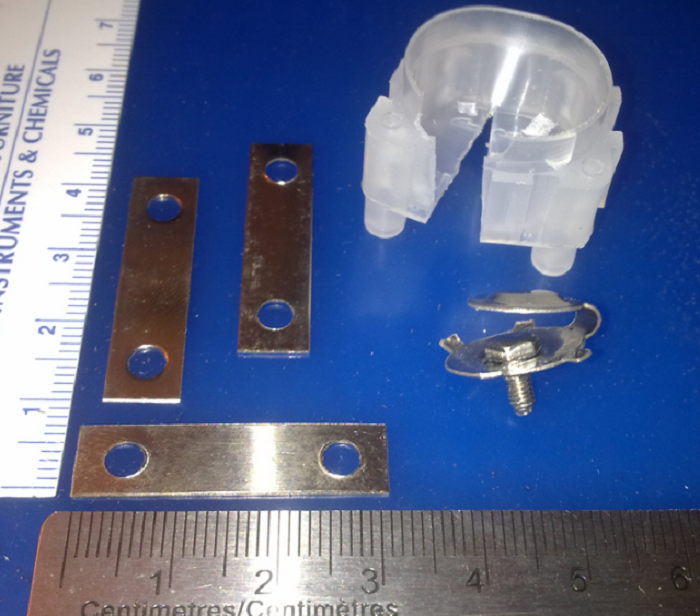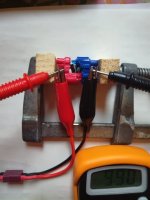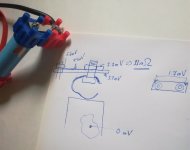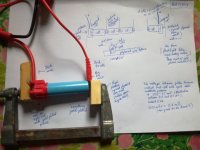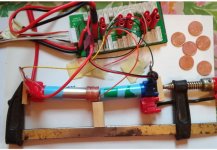How much do the Vruzend kit "caps" add to the internal resistance of each cell?
With 2 Vruzend caps around one 18650 cell and their nickel strips in place I first measured with a voltmeter the resistance between the outer holes of the nickel strips, one probe at plus, another probe at minus. The voltage was 4.11 V.
Then I connected a bicycle lamp (6V, 2.4 W) to the cell. The lamp lit, and the amperage was 0.30 A
With the lamp lit the voltage was 4.05 V. The sagging was 4.11V-4.05V = 60 millivolts. From Ohms law R= U/I = 60mV/0.3 A= 200 milliohms.
----
How much of this 200 milliohms is inside the cell and how much caused by the Vruzend parts? Would it be reasonable to improve Vruzend parts, how much could we gain?
I kept the above circuit with the lamp. I tried to measure resistance with 4-wire resistance measurement : https://en.wikipedia.org/wiki/Four-terminal_sensing
From another cell I removed insulation from a 1 cm2 spot on the side of the cell. It is known to be negative terminal(!). The positive terminal is empty and not used at all. To the negative end I put the Vruzend part, with nickel strip. Then the 0.3 ampere current was arranged through the bare side spot, Vruzend, through the nickel strip.
With voltmeter probes at the bare side spot and the outer hole of the nickel strip gave 8.8 millivolts. Again from Ohms law we get resistance R = 8.8 mV/0.30 A = 30 mOhm.
Hmm, not very bad, or is it? Or is there an important error somewhere here? (the temperature is ignored here).
--------------
When there are 2 Vruzend parts per cell they have together about 60 milliohms and the true cell direct current internal resistance is
Edit oct 12: internal resistance is milliOhms, not milliVolts 200 mOhm - 2*30 mOhm = 140 mOhm.
But here is major error in my thoughts: heat loss is depending of the configuration (Serial/parallel connections). 45W is lost in ONE cell, but of course such currents are not possible in one cell. Ignore the following black lines, I'll write about a new post later today.
Ok, now the correction: Total_Power_to_heat =( I_total_to_ESC ² / N_parallel)*N_serial*R. Eg. (15A*15A/10) * 10 * 0.2Ohm = 45W ,for 10S10P
My ESC takes at most 15 A, and the Voltage is 36V (40V to calculate easier). At max power heat in the cells and Vruzend parts is I²*R = 15A*15A* 0.2 Ohm = 45 W. The total power P = U*I = 40V*15A = 600 W. The percentage to heat is 45/600 = 7.5 %
Of those 45 watts Vruzend's share is 60mOhm/200 milliohm = 13.5 W. For me this would be tolerable so far compared to the pedalling effort. However, 45 W in a small volume would mean overheating, probably (?), so the average power should be less.
Has somebody else test results?
Thoughts, corrections, remarks?
With 2 Vruzend caps around one 18650 cell and their nickel strips in place I first measured with a voltmeter the resistance between the outer holes of the nickel strips, one probe at plus, another probe at minus. The voltage was 4.11 V.
Then I connected a bicycle lamp (6V, 2.4 W) to the cell. The lamp lit, and the amperage was 0.30 A
With the lamp lit the voltage was 4.05 V. The sagging was 4.11V-4.05V = 60 millivolts. From Ohms law R= U/I = 60mV/0.3 A= 200 milliohms.
----
How much of this 200 milliohms is inside the cell and how much caused by the Vruzend parts? Would it be reasonable to improve Vruzend parts, how much could we gain?
I kept the above circuit with the lamp. I tried to measure resistance with 4-wire resistance measurement : https://en.wikipedia.org/wiki/Four-terminal_sensing
From another cell I removed insulation from a 1 cm2 spot on the side of the cell. It is known to be negative terminal(!). The positive terminal is empty and not used at all. To the negative end I put the Vruzend part, with nickel strip. Then the 0.3 ampere current was arranged through the bare side spot, Vruzend, through the nickel strip.
With voltmeter probes at the bare side spot and the outer hole of the nickel strip gave 8.8 millivolts. Again from Ohms law we get resistance R = 8.8 mV/0.30 A = 30 mOhm.
Hmm, not very bad, or is it? Or is there an important error somewhere here? (the temperature is ignored here).
--------------
When there are 2 Vruzend parts per cell they have together about 60 milliohms and the true cell direct current internal resistance is
Edit oct 12: internal resistance is milliOhms, not milliVolts 200 mOhm - 2*30 mOhm = 140 mOhm.
But here is major error in my thoughts: heat loss is depending of the configuration (Serial/parallel connections). 45W is lost in ONE cell, but of course such currents are not possible in one cell. Ignore the following black lines, I'll write about a new post later today.
Ok, now the correction: Total_Power_to_heat =( I_total_to_ESC ² / N_parallel)*N_serial*R. Eg. (15A*15A/10) * 10 * 0.2Ohm = 45W ,for 10S10P
My ESC takes at most 15 A, and the Voltage is 36V (40V to calculate easier). At max power heat in the cells and Vruzend parts is I²*R = 15A*15A* 0.2 Ohm = 45 W. The total power P = U*I = 40V*15A = 600 W. The percentage to heat is 45/600 = 7.5 %
Of those 45 watts Vruzend's share is 60mOhm/200 milliohm = 13.5 W. For me this would be tolerable so far compared to the pedalling effort. However, 45 W in a small volume would mean overheating, probably (?), so the average power should be less.
Has somebody else test results?
Thoughts, corrections, remarks?


